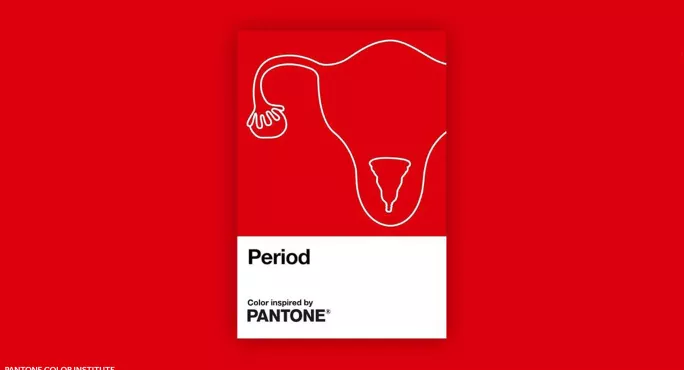- Home
- Will Pantone’s ‘Period Red’ help us talk about periods?
Will Pantone’s ‘Period Red’ help us talk about periods?

In recent months, we have seen a growth in advertisements that are bold, yet honest. The recent campaign from This Girl Can is an ongoing initiative by Sport England to try and get more women to exercise. It shows a woman slipping on her yoga leggings with her tampon string clearly visible.
Tampax, meanwhile, faced a backlash against its most recent advert, including a ban in Ireland. With the title “Tampax and Tea”, the advert focuses on how to insert a tampon correctly, with the slogan “You’ve gotta get ’em up there, girls”.
Uncomfortable as it may feel, it is true. Now Pantone, a colour standards agency, has launched a new colour. “Period” is described as an “original shade of red that represents a steady flow”.
Pantone isn’t shy about using its unique colour system for the greater good, having previously thrown its colours behind campaigns by Save the Children and the Ocean Agency. This new colour is designed to highlight social issues and stigmas.
Education about periods
Some may say any publicity is good publicity, and anything that helps to start the conversation can only be worthwhile.
But what will young girls think about the term “period red”? I mean, what is period red? Any woman can tell you that periods aren’t necessarily red. You get shades of red, and sometimes it is just not red: it is black, brown or even pink. Will girls question their redness and wonder whether they are normal?
And will all the potential hysteria about period colour detract from the most challenging part of menstruating? For some girls and women, they suffer - and I mean suffer - with cramps, changes in their emotions, sore boobs, headaches, back pain and mood swings.
And let’s not forget the period walk. You know, the one where you have to take your bag to the toilets so that you can change your sanitary wear? The walk that sometimes needs to be done halfway through a lesson, so then everyone knows you have your period, as you scuttle out of the classroom with your school bag.
Schools have a huge part to play in this. Not just in helping to fight the stigma, but in supporting the girls who live through utter misery each month. Two-thirds of girls have missed classes because of stigma and shame. The thought of having to sit through double maths when you’ve got a heavy period and you know you’re going to have to ask to go to the toilet halfway through is not a reason for girls to miss school. Let’s not forget that period shame can lead to lifelong poverty, and many women face unnecessary adversity around their periods.
But, hang on - while we’re at it, we also need to go the whole hog and educate girls about what happens at the other end, when you hit 50ish and are faced with the menopause. We need to be realistic and teach our 11-years-olds that menopause can bring its own set of challenges, and that it’s part of the period journey.
The menstrual cycle has its place in biology lessons, but we must teach our students - yes, I mean students: girls and boys - that this magic 28-day cycle just ain’t gonna happen for some.
The reality of menstruation
The problem, of course, with all this is that it makes some teachers feel uncomfortable. Spare a thought for the poor male teacher who has to teach PSHE to Year 7, and ends up having to talk to 30 kids about periods.
So, rather than spending another Inset day discussing differentiation or the latest whizzy app, let’s get down to it and talk about periods. We need to know how to teach it and how to talk about it. PSHE lessons need to get to the nitty-gritty and use terminology like dysmenorrhea, moon cups and endometriosis. In order for us to open up the conversation, to get rid of the stigma, the taboo, the shame, we need to go further than the biology, and start talking about the reality of it.
Anyway, back to Pantone and its oh-so-red perfect square. As with the perfect 28-day cycle, mapped out in the biology textbook, we need to be careful that we don’t sell our students a lie.
Having grown up with the “Whoah, Bodyform! Bodyform for youuu” advert, I was sold the lie. I thought period blood was blue until I was about 9, courtesy of its sanitary-towel demonstration. Periods aren’t about dancing around the kitchen in white knickers - they are about much more than that. Yes, the recent Tampax advert may have sat uncomfortably for many, but it took a step towards removing the censorship women face when talking about their bodies.
We need companies like Pantone to be bold and brave, and put periods in the mainstream. But schools have a pivotal role in changing the rhetoric, too. Why not start with the new Pantone image up on the board: “Morning. Who thinks periods are this colour?” Now that would start the conversation.
Emily Gunton is director of music, head of co-curricular and outreach and school consultant teacher at Blackheath High School
Keep reading for just £1 per month
You've reached your limit of free articles this month. Subscribe for £1 per month for three months and get:
- Unlimited access to all Tes magazine content
- Exclusive subscriber-only stories
- Award-winning email newsletters



